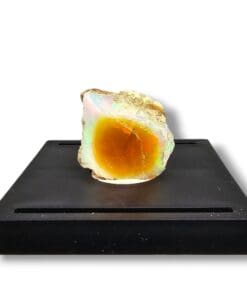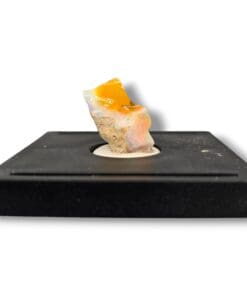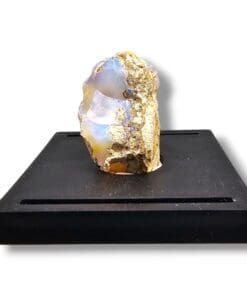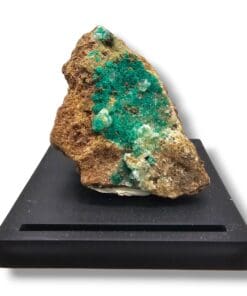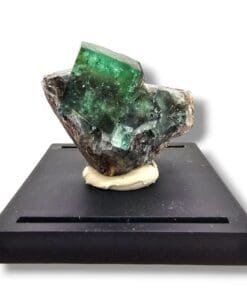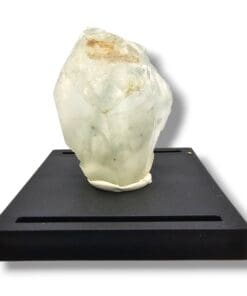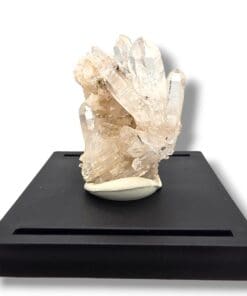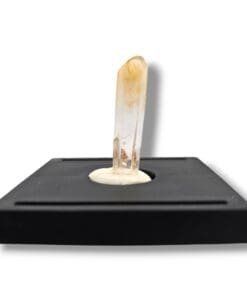Aquamarine: Unveiling the Serene Beauty of a Collector’s Gem
Introduction
Did you know that Aquamarine, named for its sea-water color, has been cherished as a symbol of youth, hope, and health for centuries? This alluring gemstone, celebrated for its tranquil blue-to-greenish hues, has captivated collectors and jewelry enthusiasts alike. In this comprehensive exploration, we’ll dive into the depths of Aquamarine’s history, its place in various cultures, and the reasons behind its enduring popularity in gem collections.
Historical Significance of Aquamarine
Aquamarine’s legacy traces back to ancient times when it was revered by sailors as a talisman for good luck, fearlessness, and protection. This gemstone has been adorned by various civilizations, with each attributing unique meanings and powers to it. From being used by the Romans in their exquisite jewelry to its use in the crowns of royalty, Aquamarine has always been distinguished in human history.
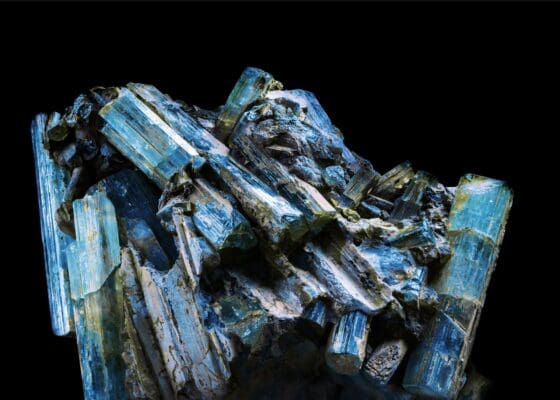
Geological Formation and Properties of Aquamarine
Aquamarine is a variety of the mineral beryl formed in granite pegmatites and metamorphic rocks. Its enchanting color, which ranges from a light, almost transparent blue to a richer teal, is typically due to iron impurities within the mineral. On the Mohs scale of hardness, Aquamarine scores a solid 7.5 to 8, making it both a durable and a beautiful choice for jewelry.
Rarity, Collector’s Perspective, and Identifying Authentic Aquamarine
Rarity and Value in the Collector’s Market: Aquamarine, especially in its most prized deep blue tones, is a gemstone that holds significant allure in the collector’s market. While lighter shades of Aquamarine are more common, the deeper and more intense the color, the rarer and more valuable the stone becomes. The presence of naturally occurring deep blue Aquamarine without the need for enhancement is particularly rare and sought after by collectors.
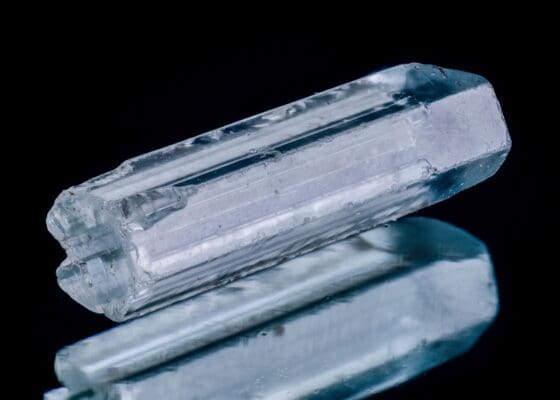
Identifying Genuine Aquamarine: To distinguish authentic Aquamarine from imitations or lower-quality stones, one should look for its signature blue to greenish-blue color. Genuine Aquamarine is also characterized by its glass-like luster and clarity. Imitations, such as glass or synthetic spinel, often lack the subtle variations and inclusions found in natural Aquamarine. A hardness test can also help, as Aquamarine will scratch glass due to its Mohs hardness of 7.5 to 8.
Characteristics of High-Quality Aquamarine: High-quality Aquamarine is judged on its color, clarity, cut, and carat weight. The most desirable Aquamarine exhibits a deep, vibrant blue color with high clarity, free of visible inclusions. Well-executed cuts not only enhance the stone’s brilliance but also its overall color and visual appeal.
Market Value of Aquamarine
Current Market Value: The value of Aquamarine varies depending on its quality. Factors such as depth of color, clarity, and quality of cut significantly influence its price. Darker, more saturated blues tend to have a higher market value. The size of the gemstone also plays a crucial role, with larger specimens of high quality fetching premium prices.
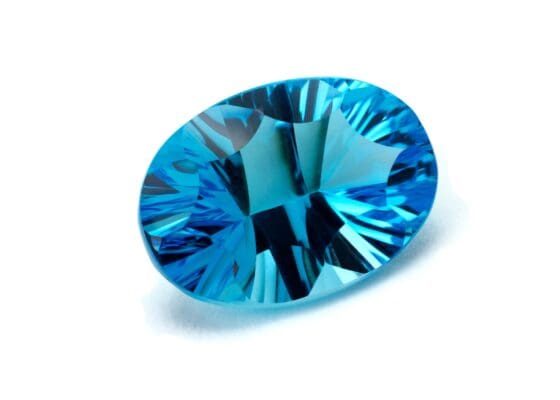
Factors Influencing Price: The main factors that influence the price of Aquamarine include its color (with the more intense blues being more valuable), clarity (the fewer the inclusions, the higher the value), and the cut (well-cut stones that display the color and clarity effectively are more desirable). The provenance of the stone can also affect its value, with certain locations known for producing particularly high-quality Aquamarine.
Major Locations and Mining of Aquamarine
Key Mining Locations: Aquamarine is mined in various parts of the world, with major sources including Brazil, Nigeria, Madagascar, Zambia, The United States, and Pakistan. Brazil, in particular, is renowned for producing large and high-quality Aquamarine stones.
The Rarity of Aquamarine in Different Regions: While Aquamarine is found in several countries, the rarity and quality of the gemstone can vary significantly. For instance, Brazilian Aquamarine is often noted for its size and clarity, whereas African Aquamarine is typically known for its richer colors. The unique geological conditions of each region contribute to the distinctive qualities of the Aquamarine found there.
Uses and Applications of Aquamarine
Aquamarine in Jewelry and Decorative Arts: Aquamarine is a favored gemstone in jewelry due to its captivating blue hues, reminiscent of seawater. It’s often used in engagement rings as a symbol of serenity and eternal love. Beyond rings, Aquamarine is also featured in necklaces, earrings, bracelets, and brooches, where its tranquil color can be showcased against various metals, particularly silver and white gold. In decorative arts, Aquamarine is used in sculptures, carvings, and ornamental pieces, valued for its beauty and the delicate touch it adds to artworks.
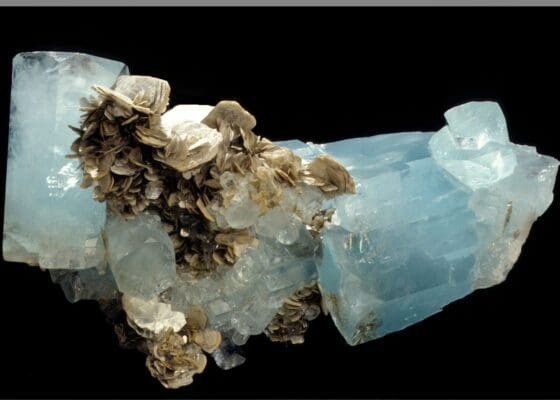
Unique Applications and Care Instructions: While primarily known for its use in jewelry, Aquamarine has also been used in eyewear and optical lenses due to its clarity. In terms of care, Aquamarine should be protected from hard knocks and extreme temperature changes, as it can be prone to cracking. Cleaning with warm soapy water and a soft brush is typically recommended to maintain its luster.
Metaphysical Properties, Beliefs, and Symbolism
Metaphysical Beliefs: Aquamarine is believed to possess calming and soothing energies, making it a popular stone in various healing and spiritual practices. It is thought to promote clear communication, and tranquility, and to soothe fears and phobias.
Aquamarine as a Spiritual and Healing Stone: In spiritual circles, Aquamarine is associated with the throat chakra, enhancing clear expression and communication. It’s also believed to aid in meditation and to provide protection during travel, especially over water.
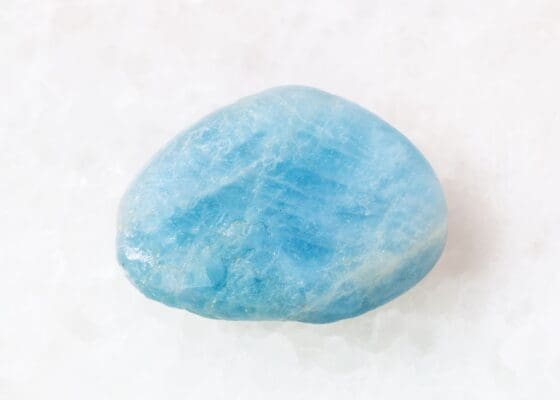
Symbolism and Folklore: Historically, Aquamarine has been a symbol of youth, health, and hope. Sailors often carried Aquamarine to protect them on voyages. It’s also associated with the Greek and Roman gods of the sea. In various cultures, it is believed to bring happiness in marriage and to reawaken love in long-married couples.
Aquamarine in Jewelry
Usage in Jewelry Making: Aquamarine is highly valued in jewelry making for its versatility and durability (7.5-8 on the Mohs scale). Its range of blue tones, from pale to deep blue, allows for creative and varied designs, catering to a wide range of styles and preferences.
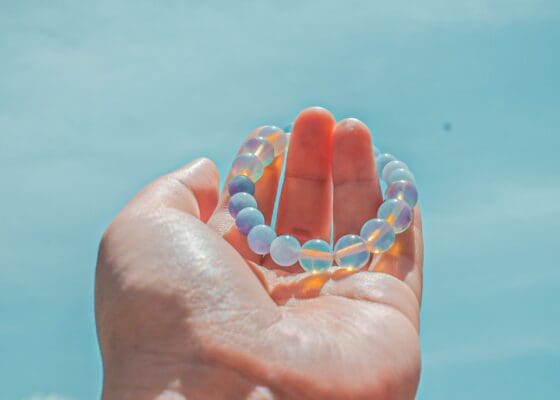
Popular Jewelry Styles: Aquamarine is often cut into faceted shapes to enhance its natural sparkle and is sometimes fashioned into cabochons for a more subtle effect. It is a popular choice for both modern and vintage-inspired engagement rings. Other popular styles include solitaire pendants, drop earrings, and delicate bracelets, where its serene blue can be the centerpiece.
Fun Facts and Trivia about Aquamarine
Ancient Roman Belief: The Romans believed that Aquamarine could cure diseases of the stomach, liver, and throat.
Royal Favoritism: Queen Elizabeth II has been known to wear Aquamarine jewelry, having received many pieces as gifts.
Largest Aquamarine: The largest gem-quality Aquamarine, found in Brazil, weighed 110.5 kg and was named the “Dom Pedro Aquamarine.”
Aquamarine and Mermaids: Folklore often links Aquamarine with mermaids’ treasure, believed to be kept in the depths of the sea.
Wedding Anniversary Stone: Aquamarine is traditionally given as a gift for the 19th wedding anniversary.
Answers to Top Questions from Google’s ‘People Also Ask’
- What is the Aquamarine stone good for?
Aquamarine is highly valued for its calming and soothing properties. Traditionally, it’s believed to enhance clear and compassionate communication and is often used in meditation for its stress-relieving qualities. Aquamarine is thought to be particularly beneficial for those seeking mental clarity and emotional balance, making it a favored stone in both personal and professional settings. - Is Aquamarine a valuable gem?
Aquamarine is indeed considered a valuable gemstone, with its worth significantly influenced by the depth and vibrancy of its blue color. High-quality Aquamarine, exhibiting deep blue hues with high levels of clarity and expert cut, can command premium prices in the market. The larger the stone and the more intense its color, the more valuable it is deemed by collectors and jewelers alike. - What does Aquamarine mean spiritually?
In the realm of spiritual symbolism, Aquamarine is closely associated with tranquility, serenity, and clarity. It’s believed to facilitate a peaceful and clear state of mind, promoting spiritual awakening and enhancing intuition. Aquamarine is often used in spiritual practices to foster self-expression and understanding, making it a cherished stone in various metaphysical communities. - Who should wear Aquamarine stone?
While Aquamarine is suitable for everyone, it is especially recommended for those who seek relaxation and mental clarity. People engaged in creative or communication-driven professions may find it particularly beneficial. Additionally, Aquamarine is thought to be supportive for individuals who are prone to stress and anxiety, offering a soothing presence. - What not to do with Aquamarine?
To maintain the beauty and integrity of Aquamarine, it is advisable to avoid exposing it to harsh chemicals, such as those found in cleaning agents or cosmetics. Sudden temperature changes should also be avoided, as they can cause damage to the stone. When storing Aquamarine, it’s best to keep it separate from harder gemstones to prevent scratches. - Can you wear Aquamarine every day?
Aquamarine is durable enough (7.5-8 on the Mohs scale) to be worn daily, but it should be handled with care to preserve its appearance. Regular cleaning and careful storage will help maintain its sparkle and prevent damage. It’s a popular choice for everyday jewelry due to its serene color and durability. - Why not use Aquamarine as an engagement ring?
Aquamarine makes for a beautiful and unique engagement ring, offering a symbol of serenity and fidelity. However, being slightly softer than diamonds, it requires mindful wear and care to avoid potential scratches or damage. For those who value color and symbolism over traditional choices, Aquamarine is an enchanting alternative. - Is it good to sleep with Aquamarine?
Sleeping with Aquamarine is believed by some to promote a calming and restorative atmosphere conducive to peaceful sleep. It’s thought to aid in emotional healing and enhance dream clarity, making it a preferred stone for nighttime wear or placement under the pillow. - How can you tell if Aquamarine is real?
Genuine Aquamarine is distinguishable by its clearness and absence of significant inclusions, along with its characteristic blue-to-blue-green hue. It should feel cool to the touch and should not display any bubbles, a common sign of glass imitations. Professional gemological assessments can provide definitive identification. - How much should I pay for Aquamarine?
The cost of Aquamarine can vary widely based on its quality. The most important factors determining its price include the intensity of its blue color, its clarity, the skillfulness of its cut, and its overall size. Deeper, more vividly colored stones with high clarity and expert craftsmanship are typically at the higher end of the price spectrum. - What color Aquamarine is most valuable?
The most sought-after and valuable Aquamarine color is a rich, deep blue. This shade is less common than lighter blue or greenish varieties, making it more prized in the gemstone market. The deeper and more saturated the blue, the higher the value of the Aquamarine. - How can you tell if Aquamarine is high quality?
High-quality Aquamarine is characterized by a deep and vivid blue color, with minimal inclusions and a well-executed cut that enhances its natural sparkle. Clarity is another crucial factor, as the fewer the inclusions, the more valuable the stone. A high-quality Aquamarine will display its color uniformly and effectively, contributing to its overall allure and value.

Aquamarine Quiz for Collectors and Enthusiasts
Test Your Knowledge of Aquamarine!
- What is Aquamarine’s rank on the Mohs scale of hardness?
A) 6
B) 7.5-8
C) 9 - Which of the following colors is the most valuable in Aquamarine?
A) Light Blue
B) Deep Blue
C) Greenish-Blue - Aquamarine is a variety of which mineral?
A) Quartz
B) Beryl
C) Topaz - What is the traditional wedding anniversary for gifting Aquamarine?
A) 10th
B) 15th
C) 19th - Metaphysically, Aquamarine is believed to be associated with which chakra?
A) Heart Chakra
B) Throat Chakra
C) Root Chakra
Check your answers at the bottom and see how much you know about Aquamarine! Whether you’re a gem collector, interested in geology, or fascinated by the metaphysical world, Aquamarine offers a realm of discovery and enchantment. Share your score in the comments and join the conversation about this beautiful gemstone!
Conclusion
As we conclude our exploration of the enchanting world of Aquamarine, we’re reminded of its unique place in both the natural world and human culture. Known for its captivating blue hues that mirror the tranquil sea, Aquamarine has been a gemstone of lore and fascination through the ages. Its allure lies not just in its serene beauty but also in its versatility, making it a cherished choice for jewelry, decorative arts, and spiritual practices. Aquamarine’s blend of elegance and mythical significance continues to enchant collectors, jewelers, and spiritual seekers alike.
-
 Exquisite Ethiopian Opal Gemstone from Ethiopia
Exquisite Ethiopian Opal Gemstone from Ethiopia$34$31 -
 Delicate Ethiopian Opal from Ethiopia
Delicate Ethiopian Opal from Ethiopia$24$22 -
 Stunning Ethiopian Opal – Your Hydrophane Gem from Ethiopia
Stunning Ethiopian Opal – Your Hydrophane Gem from Ethiopia$60$54 -
 Captivating Ethiopian Opal Specimen – Pristine Display from Ethiopia
Captivating Ethiopian Opal Specimen – Pristine Display from Ethiopia$24$22 -
 Striking Dioptase with Quartz Matrix from Shaba, Zaire
Striking Dioptase with Quartz Matrix from Shaba, Zaire$40$36 -
 Vibrant Fluorescent Green Fluorite Cluster from Rogerley Mine, England
Vibrant Fluorescent Green Fluorite Cluster from Rogerley Mine, England$55$50 -
 Green Quartz Crystal from Boyaca, Colombia – Pristine Mineral Display
Green Quartz Crystal from Boyaca, Colombia – Pristine Mineral Display$44$40 -
 Pink Lemurian Quartz Cluster from Santander, Colombia
Pink Lemurian Quartz Cluster from Santander, Colombia$40$36 -
 Exquisite Mango Quartz Cluster from Boyaca, Colombia
Exquisite Mango Quartz Cluster from Boyaca, Colombia$32$29
For those who have been captivated by the serene beauty of Aquamarine and wish to own a piece of this tranquil gemstone, we invite you to explore our exquisite collection of Aquamarine products. From elegant jewelry pieces that showcase the stone’s soothing hues to unique collector’s items, our selection caters to all tastes and preferences. Discover the perfect Aquamarine piece for your collection in our Aquamarine Collection.
Related Rocks and Minerals
Broaden your gemstone horizons with these related articles and products:
- Topaz: Delve into the vibrant and cheerful world of Topaz, another beloved blue gemstone.
- Sapphire: Explore the deep and royal blues of Sapphire, a gemstone known for its elegance and durability.
- Morganite: Discover Morganite’s delicate pink hues, a beryl cousin to Aquamarine.
- Emerald: Learn about Emerald, the green variety of beryl, known for its lush and vivid color.
- Tourmaline: Uncover the diverse color spectrum of Tourmaline, from pinks and greens to captivating blues.
References and Further Reading
For more in-depth knowledge about Aquamarine, consider these credible sources:
- Gemological Institute of America (GIA): Provides authoritative information on Aquamarine’s properties, history, and grading.
- Minerals.net: Offers detailed insights into the mineralogical aspects of Aquamarine.
Further, enrich your understanding of gemstones by exploring our related articles:
- [The Vibrant World of Colored Gemstones: A Comprehensive Guide] Coming Soon
- [Understanding Gemstone Treatments and Enhancements] – Coming Soon
These resources, along with the provided internal links, not only enhance your knowledge of Aquamarine but also support a broader exploration of the fascinating world of gemstones.
Answers to the Quiz:
- Answer: B) 7.5-8
- Answer: B) Deep Blue
- Answer: B) Beryl
- Answer: C) 19th
- Answer: B) Throat Chakra


